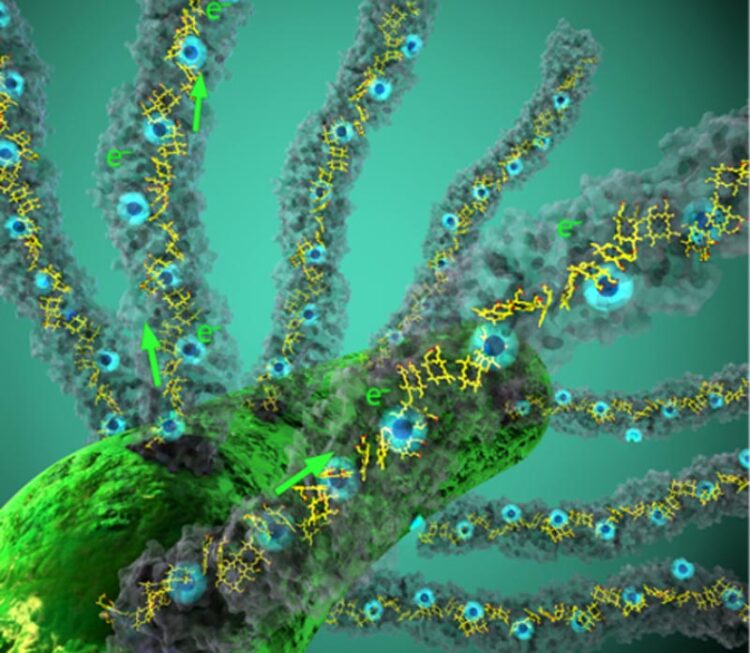How microbes make ‘nanowires’ to exhale electrons

Geobacter in green, nanowires in gray and embedded hemes are shown in yellow with electrons in blue
Image Credit: Sibel Ebru Yalcin, Nikhil Malvankar,and Ella Maru Studio
The rising temperatures threatening life on our planet are caused in part by microbes that produce 50% of atmospheric methane, a gas 30 times more potent than CO2 at trapping heat. Surprisingly, another kind of microbe combats these rising temperatures by consuming up to 80% of methane released from ocean sediments. How are some microbes methane producers and others methane consumers?
To solve this puzzle, an international team of researchers, Nikhil Malvankar (Yale University, USA), Carlos Salgueiro (NOVA University of Lisbon, Portugal), Lisa Craig (Simon Fraser University, Canada) and Olivera Francetic (Institut Pasteur, France), have received one of the 25 Human Frontier Science Program Awards for cutting edge, high-risk high-reward projects.
The team will study the wire-like filaments made by electricity-producing Geobacter, which resemble methane-eating microbes. These “nanowires” allow microbes to exchange electrons with their partners, with the direction of current determining whether methane is produced or consumed.
Nanowires were first reported over two decades ago and until very recently were thought to be type IV pili. However, Malvankar lab recently revealed that the conductive filaments of Geobacter are in fact polymers of cytochrome proteins, which contain metal-coordinating hemes that line up to create a continuous path along which electrons travel. The role of the Geobacter pili may actually be to assemble and secrete these cytochrome nanowires.
The team’s collective expertise in nanowires (Malvankar), heme proteins (Salgueiro), type IV pili (Craig) and bacterial secretion (Francetic) will help unravel how the complex pilus machinery helps microbes produce nanowires.
Media Contact
Bess Connolly
Yale University
elizabeth.connolly@yale.edu
Cell: 203-410-5032
All latest news from the category: Awards Funding
Newest articles
Faster, more energy-efficient way to manufacture an industrially important chemical
Zirconium combined with silicon nitride enhances the conversion of propane — present in natural gas — needed to create in-demand plastic, polypropylene. Polypropylene is a common type of plastic found…

Energy planning in Ghana as a role model for the world
Improving the resilience of energy systems in the Global South. What criteria should we use to better plan for resilient energy systems? How do socio-economic, technical and climate change related…

Artificial blood vessels could improve heart bypass outcomes
Artificial blood vessels could improve heart bypass outcomes. 3D-printed blood vessels, which closely mimic the properties of human veins, could transform the treatment of cardiovascular diseases. Strong, flexible, gel-like tubes…





















